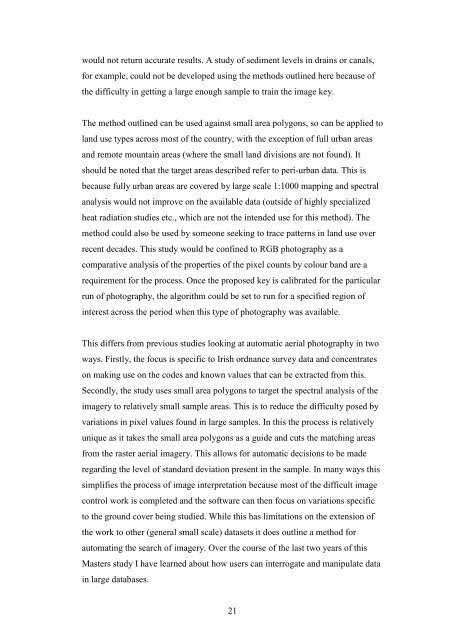You also want an ePaper? Increase the reach of your titles
YUMPU automatically turns print PDFs into web optimized ePapers that Google loves.
would not return accurate results. A study of sediment levels in drains or canals,<br />
for example, could not be developed using the methods outlined here because of<br />
the difficulty in getting a large enough sample to train the image key.<br />
The method outlined can be used against small area polygons, so can be applied to<br />
land use types across most of the country, with the exception of full urban areas<br />
and remote mountain areas (where the small land divisions are not found). It<br />
should be noted that the target areas described refer to peri-urban data. This is<br />
because fully urban areas are covered by large scale 1:1000 mapping and spectral<br />
analysis would not improve on the available data (outside of highly specialized<br />
heat radiation studies etc., which are not the intended use for this method). The<br />
method could also be used by someone seeking to trace patterns in land use over<br />
recent decades. This study would be confined to RGB photography as a<br />
comparative analysis of the properties of the pixel counts by colour band are a<br />
requirement for the process. Once the proposed key is calibrated for the particular<br />
run of photography, the algorithm could be set to run for a specified region of<br />
interest across the period when this type of photography was available.<br />
This differs from previous studies looking at automatic aerial photography in two<br />
ways. Firstly, the focus is specific to Irish ordnance survey data and concentrates<br />
on making use on the codes and known values that can be extracted from this.<br />
Secondly, the study uses small area polygons to target the spectral analysis of the<br />
imagery to relatively small sample areas. This is to reduce the difficulty posed by<br />
variations in pixel values found in large samples. In this the process is relatively<br />
unique as it takes the small area polygons as a guide and cuts the matching areas<br />
from the raster aerial imagery. This allows for automatic decisions to be made<br />
regarding the level of standard deviation present in the sample. In many ways this<br />
simplifies the process of image interpretation because most of the difficult image<br />
control work is completed and the software can then focus on variations specific<br />
to the ground cover being studied. While this has limitations on the extension of<br />
the work to other (general small scale) datasets it does outline a method for<br />
automating the search of imagery. Over the course of the last two years of this<br />
Masters study I have learned about how users can interrogate and manipulate data<br />
in large databases.<br />
21
















